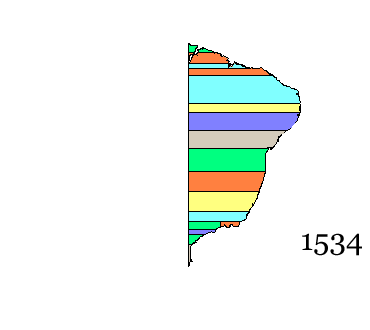| Country | Length (km) | Bordering Brazilian states | Border features | Border crossings | Article link |
|---|
 France (French Guiana) France (French Guiana) | 730 | Amapá | Oyapock | Franco-Brazilian Binational Bridge | Brazil–France border |
 Suriname Suriname | 593 | Amapá, Pará | Defined by the Treaty of Limits as the drainage divide between the Amazon basin to the south, and the basins of the rivers flowing north to the Atlantic Ocean | | Brazil–Suriname border |
 Guyana Guyana | 1,606 | Pará, Roraima | Takutu River, Ireng River | Takutu River Bridge | Brazil–Guyana border |
 Venezuela Venezuela | 2,200 | Amazonas, Roraima | | Highway BR-174 near the Brazilian city Pacaraima | Brazil–Venezuela border |
 Colombia Colombia | 1,644 | Amazonas | Japurá River, Apaporis River, Traíra River, Papurí River, Vaupés River, Içana River, Rio Cuiari | The adjoining Colombian city Leticia and the Brazilian city Tabatinga | Brazil–Colombia border |
 Peru Peru | 2,995 | Acre, Amazonas | Acre River, Javary River, Amazon River, Santa Rosa River, Purus River, 10th parallel south | Brazil-Peru Integration Bridge | Brazil–Peru border |
 Bolivia Bolivia | 3,423 | Acre, Mato Grosso, Mato Grosso do Sul, Rondônia | Paraguay River, Tamengo Canal [ es ], Mandioré Lake, Madeira River, Mamoré River, Abuna River, Acre River | - Wilson Pinheiro Binational Bridge (pt) (named Friendship Bridge by Bolivia) over the Acre River connecting the Bolivian city Cobija to the Brazilian city Brasiléia
- The adjoining Bolivian city Cobija and the Brazilian city Epitaciolândia
- A bridge over the Tamengo Canal [ es ] joining the Bolivian city Puerto Quijarro and the Brazilian city Corumbá
| Bolivia–Brazil border |
 Paraguay Paraguay | 1,365 | Mato Grosso do Sul, Paraná | Paraná River, Itaipu Lake, Apa River, Paraguay River | - A bridge crossing the Apa River connecting the Brazilian city Bela Vista and the Paraguayan city Bella Vista Norte
- The adjoining Brazilian city Paranhos and the Paraguayan city Ypehú
- Itaipu Dam
- Friendship Bridge
| Brazil–Paraguay border |
 Argentina Argentina | 1,261 | Paraná, Rio Grande do Sul, Santa Catarina | Uruguay River, Pepiri-Guazu River, San Antonio River, Iguazu River, Iguazu Falls | - Tancredo Neves Bridge
- Integration Bridge
- Paso de los Libres – Uruguaiana International Bridge
- Peperi-Guazu International Bridge [ es; pt ]
- The adjoining Argentinian city Bernardo de Irigoyen and Brazilian city Dionísio Cerqueira
- Commander Andresito International Bridge [ es; pt ]
- An unnamed bridge over the San Antonio River linking the Brazilian city Santo Antônio do Sudoeste and the Argentinian city San Antonio
| Argentina–Brazil border |
 Uruguay Uruguay | 1,068 | Rio Grande do Sul | Chuí Stream, Highway 19, Lagoon Mirim, Jaguarão River, San Luis River, Quaraí River | - Baron of Mauá International Bridge
- The adjoining cities of Chuí (on the Brazilian side) and Chuy (on the Uruguayan side)
- The Brazilian and Uruguayan cities named Aceguá
- The adjoining Uruguayan city Rivera and Brazilian city Santana do Livramento
- International Bridge of Concord [ es; pt ]
- Bella Unión - Barra do Quaraí International Bridge [ es; pt ]
| Brazil-Uruguay border |















